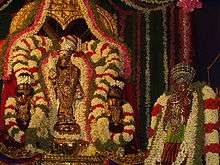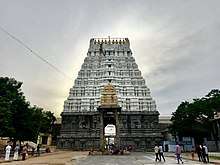Thirumal
Perumal (Tamil: பெருமாள்), or Perumaal or Thirumal (Tamil: திருமால்), also known as Mal or Mayon literally refers to a South Indian deity of "black complexion". Perumal is worshipped mainly among Tamilans in Tamil Nadu and the Tamil diaspora.

Some of the earliest known mention of Tirumal, and Tamil devotional poems to him, are found in Paripāṭal – the Sangam era poetic anthology.[1][2] He is a popular Hindu deity particularly among Tamils in Tamil Nadu and the Tamil diaspora, and in Vaishnava temples.[3] One of the richest and largest Hindu temples and monasteries complex dedicated to Tirumala is the Venkateswara temple in Tirupati, Andhra Pradesh.[4]
Popularity in Tamil Nadu
Perumal/Thirumal was the only deity who enjoyed the status of Paramporul (achieving a oneness with Paramatma) during the Sangam age. A reference to "Mukkol Pakavars" in Sangam literature indicates that only Vaishnavaite saints were holding Tridanda and were prominent during the Sangam age. Thirumal was as glorified as "the supreme deity" whose divine lotus feet could burn all evils and grant Moksha (Maru Piraparukkum Maasil Chevadi). During the post-Sangam period, his worship was further glorified by the Alwars.
Perumal Temples
Of the 108 Divyadesams according to the Alwar Saints, 106 of which are in the Earthly Realm.Prominent among these Divyadesams are:
- Sri Navamukundan Temple in Thirunavaya,Kerala,India
- Sri Ananthapadmanabhaswamy Temple in Thiruvananthapuram,Kerala, India
- Sri Varadaraja Perumal temple in Kanchipuram, Tamilnadu, India
- Sri Thirupalkadal temple in Keezhperoor, Thiruvananthapuram,Kerala, India
- Sri Oppiliappan Perumal Temple near Kumbakonam, Tamil Nadu India
- Sri Narashima Perumal Temple in Ahobilam, India
- Sri Ranganathaswamy Temple in Srirangam, India
- Sri Ranganathaswamy Temple in Nellore, Andhra pradesh, India
- Thirumaliruncholai (Kallazhagar Temple) in Madurai, India
- Thiruvengadam (Sri Venkateswara Temple), in Tirupathi, India
- Thiru Narayanapuram (SelvaPillai Perumal Temple) in Melkote, India
- Aadhi Thiruvellarai (Pundarikatchan) in Thiruvellarai, India.
Prominent Thirumal Temples in India
- Sri Sathya-Narayana Perumal Temple in T-Nagar, Chennai, India
- Sri Srinivasa Perumal Temple (TTD), in T-Nagar, Chennai, India
- Sri Vinavaraya Perumal Temple, in Ambattur, Chennai, India
- Sri Santhana Srinivasa Perumal Kovil, in Mogappair, Chennai, India
- Udumalai Tirupathi,Dhali road,Udumalpet, India
Sri Lanka
- Perumal temple in Jaffna, Sri Lanka
Malaysia
- Sri Sunderaraja Perumal Temple Klang, Malaysia
- Sri Alarmelamanga Samedha Shri Srinivasa Perumal Temple, Batu caves, Malaysia
United States of America
- Sri Venkateswara Perumal temple in the USA
- Sri Ranganatha temple in the USA
Singapore
- Sri Srinivasa Perumal Temple, Singapore
See also
References
- Kamil Zvelebil (1973). The Smile of Murugan: On Tamil Literature of South India. BRILL Academic. p. 124. ISBN 90-04-03591-5.
- V.N. Muthukumar; Elizabeth Rani Segran (2012). The River Speaks: The Vaiyai Poems from the Paripatal. Penguin Books. pp. 1–7. ISBN 978-81-8475-694-4.
- Sykes, Egerton. Who's who in non-classical mythology. Kendall, Alan, 1939- (2nd ed.). London. ISBN 9781136414442. OCLC 872991268.
- Michael D. Coogan (1998). The Illustrated Guide to World Religions. Oxford University Press. pp. 148–149. ISBN 978-0-19-521997-5.


